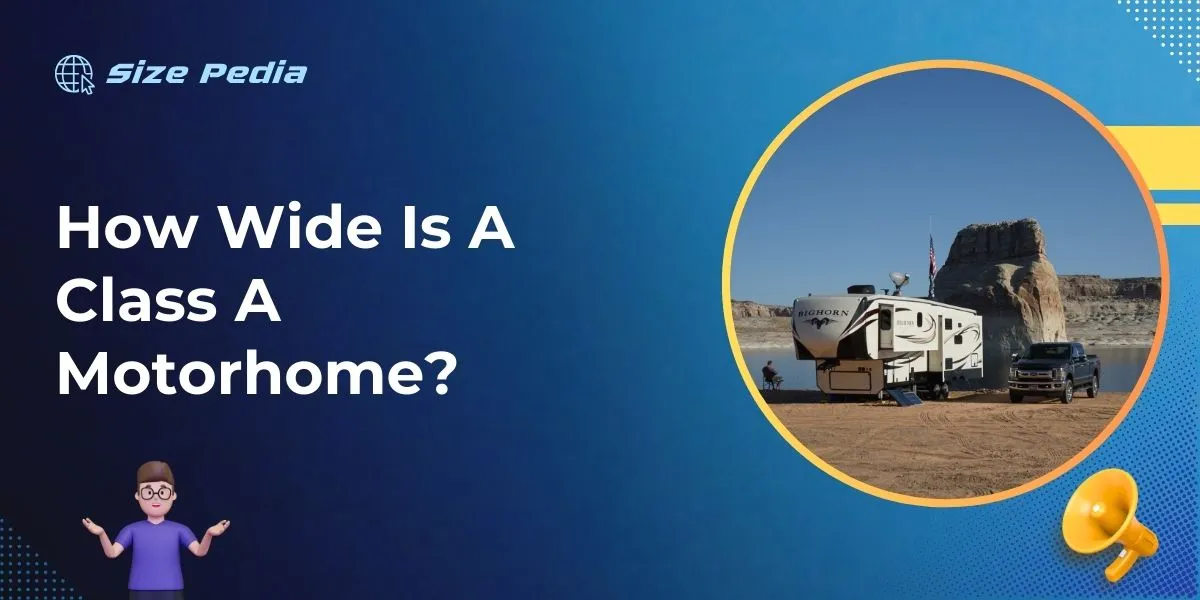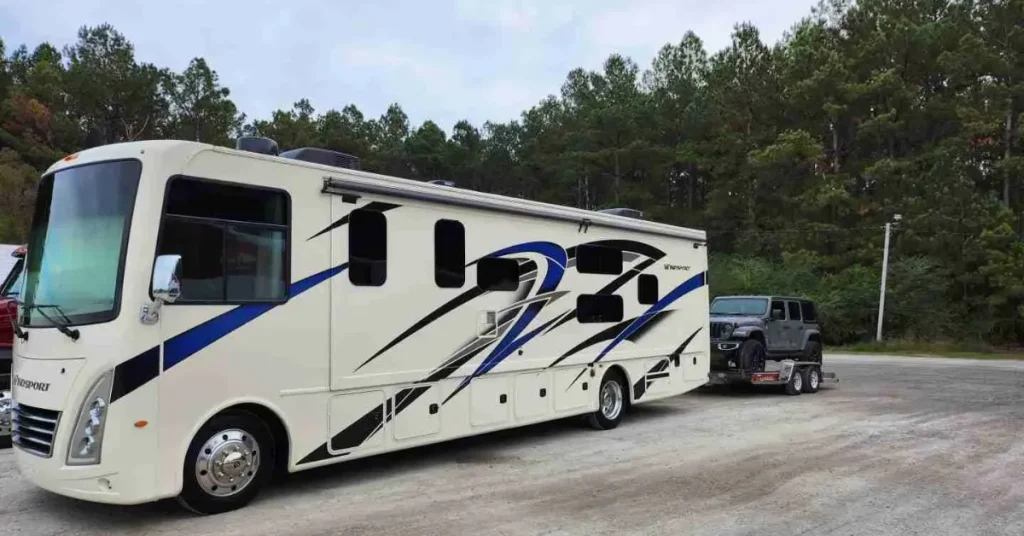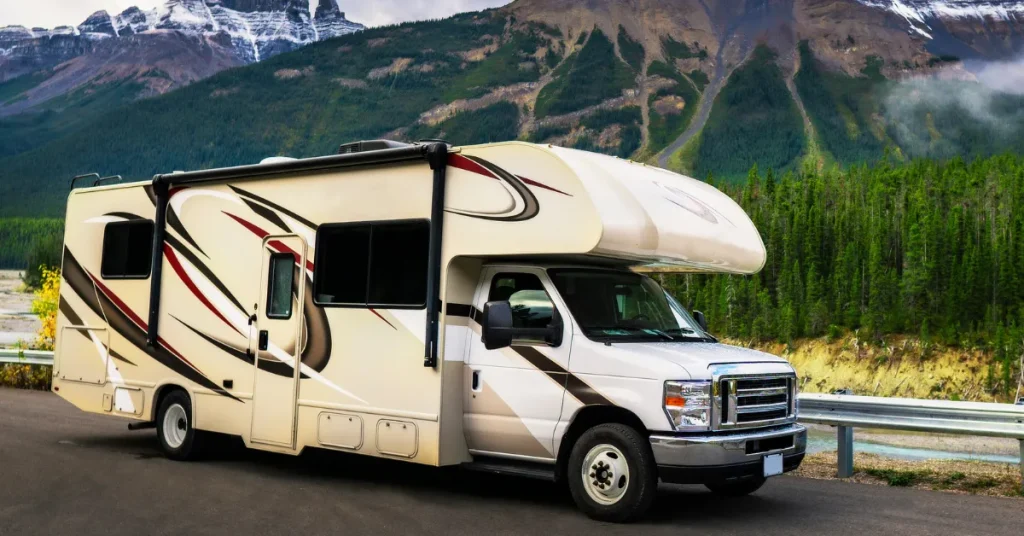Class A motorhomes typically measure between 8 to 8.5 feet in width. This width does not include side mirrors and awnings.
Embarking on the open road with all the comforts of home is a dream many achieve with a Class A motorhome. Known for their roomy interiors and robust features, Class A motorhomes are a popular choice among RV enthusiasts.
These vehicles, resembling commercial buses in shape, offer a spacious environment for travelers who don’t want to compromise on amenities.
They accommodate larger living areas, full-size kitchens, and often even slide-outs to expand living space.
Perfect for long trips or full-time living, a Class A motorhome can turn any journey into a luxurious adventure. Prospective buyers and renters should consider the width of these vehicles for navigation and campsite compatibility before investing.

Class A Motorhome Dimensions: Key Measurements
Exploring in a Class A motorhome promises comfort on the road. Understanding the size of these homes-on-wheels is crucial. Let’s delve into the dimensions that make these vehicles both spacious and challenging to navigate.
Average Width Statistics
Class A motorhomes are known for their generous interior space. Here are typical width measurements:
- Standard width: About 8 to 8.5 feet wide.
- Expansions: Slide-outs can increase width temporarily.
| Type | Average Width |
| Without Slide-Outs | 8 to 8.5 feet |
| With Slide-Outs Extended | Up to 14 feet |
Impact On Maneuverability
The width of a Class A motorhome affects how it moves on the road:
- Narrow roads become a challenge due to size.
- Turning radius: Wider vehicles have a larger turning angle.
- Parking: Requires larger spaces and more skill.
Why Size Matters For Class A Motorhomes
Class A motorhomes offer a world of adventure and comfort on the open road. The size of these luxurious homes-on-wheels plays a crucial role in the overall experience.
From room to stretch out to the ability to explore backcountry roads, the width of a Class A motorhome impacts everything.
Comfort And Space
Space is synonymous with comfort in a Class A motorhome. A wider body means:
- More living area to relax and unwind
- Roomier kitchen facilities to cook gourmet meals
- Expanded storage options for essentials
- Bigger sleeper options, essential for good rest
With larger dimensions, families enjoy separate zones for different activities. Everyone has a space to call their own.
Road Restrictions And Accessibility
The width of your Class A motorhome can affect where you can go. Consider the following:
- Narrow campsites may be off-limits.
- Parking spots can be harder to find for wider models.
- Some bridges and tunnels impose width restrictions.
- Certain scenic roads don’t allow large vehicles.
Knowing the width of your vehicle helps plan your trips to avoid inconveniences.
Comparing Class A With Other Rv Types

Comparing Class A with Other RV Types opens a window into a world of recreational vehicles with different shapes and sizes. Class A motorhomes, known for their spacious interiors, stand as the giants of the road trip kingdom.
By understanding their dimensions in relation to Class Bs and Cs, travelers make informed choices. Let’s dive into how these RV types measure up against each other.
Class B And C Size Differences
Class A motorhomes typically offer the most room, but how do Class B and C compare?
- Class B: Nicknamed “camper vans,” they are the smallest. Their lengths range from 16 to 22 feet.
- Class C: These are mid-sized options, smaller than Class As but larger than Bs. Expect lengths between 20 to 31 feet.
Widths for both Class B and C motorhomes generally stay around 7 to 8.5 feet, significantly leaner than Class A’s width, which typically stretches from 8 to 9.5 feet.
Bus Conversions And Custom Builds
Bus conversions and custom RV builds push boundaries beyond standard class sizes. These tailor-made machines often mimic Class A sizes but with a unique twist:
| Conversion Type | Length | Width |
| Bus Conversions | Up to 45 feet | Usually around 8.5 feet |
| Custom Builds | Varies | Up to 9.5 feet |
Custom RVs tailor to specific needs, with sizes that can vary greatly. They match Class A motorhomes for luxury and space but bring a personal touch to the open road.
Navigating The Challenges Of Driving A Wide Motorhome
Embracing the freedom of the open road in a Class A motorhome brings a sense of adventure. Yet, with great size comes the great responsibility of maneuvering these wonderful beasts.
Class A motorhomes typically span a generous width, making driving a task that demands respect and preparation. Conquer the road by mastering the art of driving these wide vehicles.
Required Skill Set
- Understanding vehicle dimensions is crucial to navigating roads safely.
- Adeptness at mirror usage provides a clear view of the rig’s surroundings.
- Anticipating turns and clearances prevents mishaps.
- Developing parking strategies eases the stress of tight spots.
- Cultivating spatial awareness aids in avoiding obstacles.
Selecting Campsites And Parking Spots
Selecting the right spot for your wide Class A motorhome need not be daunting. Keep these tips in mind:
- Choose campsites labeled “Big Rig Friendly.”
- Use online resources to verify site dimensions.
- Practice backing up in a wide, open area before attempting narrow camp spots.
- Call ahead to ensure campground roads are wide enough.
Finding parking requires forethought and planning as well. Consider these points:
| Location | Considerations |
| Rest Stops | Look for RV designated areas to avoid tight fits. |
| Supermarkets | Park at the periphery where there’s more space. |
| City Streets | Avoid peak hours and seek oversized parking spots. |
Legal And Practical Limitations Of Motorhome Width

Navigating the legal and practical limitations of motorhome width is crucial for any RV enthusiast. Understanding these limits ensures safe and legal road travel. Various regulations govern the size of these vehicles.
State And Federal Regulations
In the United States, motorhome widths are subject to both state and federal guidelines. The standard maximum width for RVs on federal highways is 102 inches (8.5 feet).
This does not include safety devices and mirrors. Yet, state laws may vary, so checking local regulations is vital.
- Exceptions exist in some locations.
- Always verify local road travel ordinances.
International Rv Size Considerations
International trips with an RV require understanding local size regulations. European countries, for instance, often have stricter size limits due to narrower roads. Width restrictions can be as low as 2.55 meters (8.37 feet).
- Research the destination’s RV laws.
- Check for road size and weight limits.
FAQs About How Wide Is A Class A Motorhome
How Wide Is A 40 Foot Rv?
A typical 40-foot RV is approximately 8 to 10 feet wide. Exact dimensions can vary by make and model.
How Wide Is A Class B Motorhome?
Class B motorhomes typically range from 6 to 8 feet in width, providing a compact travel solution.
How Wide Is A Winnebago Motorhome?
The width of Winnebago motorhomes varies by model, typically ranging from 6. 5 feet to 8. 5 feet. Always check specific model specifications for exact measurements.
What Is The Maximum Width Of An Rv Trailer?
The maximum width for an RV trailer in the United States is 102 inches, excluding safety equipment and mirrors.
Conclusion
Understanding the width of Class A motorhomes is crucial for potential buyers and travelers alike. These vehicles typically span 8 to 8. 5 feet, ensuring a roomy interior.
Selecting the right size can significantly enhance your road adventures. Ready for your next journey?
Consider these dimensions to choose wisely. Safe travels!
Resources:
1. https://www.nj.gov/mvc/vehicles/motorhomes.htm
